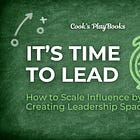I received numerous texts and personal emails of positive feedback from my network on the first two parts of this “Time to Lead” series. Let’s wrap it up with what I’m titling “Focus Architecture”. “Architect” seems to be my keyword for 2025 in this age of Ai with its ability to help you design and create new solutions easier and faster than ever.
Leadership focus is one of the hardest things in a startup.
Note: I’ve updated this post to add a classic Steve Job’s story at the very end to bring this part 3 all the way home. Don’t miss it.
Slack pings, email floods, meetings without purpose. You know these are all creating your lack of focus but you still robotically dive in to clear them to “inbox zero” and for that sense of “nothing is on my plate”. It’s this mentality, however, that ultimately drains your strategic capacity and the other leaders in your company. Everyone is in this “reactionary” and “clearing” mode.
But your strategic capacity and focus should be one of your most critical capital resources. If you can't protect your own focus capital, you can't protect your company's future.
My belief? Focus must be architected.
1. Identify the Distraction Traps
Common Executive Attention Traps:
A Slack channel culture that you model with real-time reactions.
Email threads providing the false prophets of where “the real work gets done” or where “the decisions get made.”
Meetings scheduled out of habit, not necessity.
2. Build Daily Focus Rituals
This is going to require a routine breaking mindset shift. Grab your coffee each morning and before diving into emails, slacks, etc, instead, design your day around the most influential and impactful thing you can and should make progress toward today. Write it down if you need to and/or Post It Note it to your monitor if you need to. Front and center.
Every new email or slack ping or meeting request should be evaluated against it’s true importance and/or urgency. Don’t fall back into the bad habits of being reactive to these pings if they are less important and less urgent than that Post It Note staring you in the face. P.S. Do you really need to be in that meeting being requested?
This is the type of question your new mindset shift needs to start asking yourself daily. Can’t somebody else (or even Ai and its recordings) attend on your behalf?
Some ideas:
Protect the first 90 minutes everyday for focusing on that most influential and impactful thing you know you need to do and your company needs. Don’t do email or slack during this time.
Try your own version of “Focus Sprints”. Eng/Dev teams love “sprints” because they work. Forced focus time. 30 minute blocks of critical strategic thinking/designing time blocked on your calendar for “your thing”. And then 15 minutes of task prioritization and delegation once your strategic thoughts become clear.
Try blocking 1-2 of these "No-Slack" and/or “No Email” “Strategic Thinking Focus Times”every day on your calendar. Give it 1 week. Try it. If you like it, do it for the next week. Hint: New habits require 3 weeks of consistency (neuroscience).
3. Manage Your Focus Like Capital
Your focus is a finite strategic asset. You should track it just like you track cash:
Focus Metrics:
% of week spent on Deep Work vs Reactive Work
# of Strategic Hours protected per week
# of Distraction Interruptions (self and team-caused)
Invest in your focus. It compounds.
4. Teach Your Team Focus Culture
Focus architecture is cultural, not personal. Model it. Then Coach it.
Model it:
Don't give real-time Slack replies.
Don’t expect or give real-time email replies
Encourage blocking deep work time publicly on calendars.
Normalize non-responses to low-urgency pings. Tell these low-urgent and low important requests from others that “It’s Your Decision” (as in “their decision” that doesn’t really require you). Yes, you will feel that refreshing feeling of properly delegating ownership when you establish this new habit.
Exec Team Practice: Weekly Staff Meeting Rituals
Start with team and personal individual wins, not department status updates.
Rotate meeting ownership to different individuals on the team forcing leadership down to your team members.
Ask regularly: “Where are we not operating as a team?”
Spotlight a cross-functional team success story weekly.
5. Focus On True Priorities
Focusing on the most critical things at the right time is required. Don’t confuse being focused with progress when the things being focused on are neither urgent nor important.
Speed in a start up and moving fast and being agile without focus is either running in place quickly or running in the wrong direction.
A well-prioritized roadmap is required to provide this focus. This roadmap for your team and your company provides priority guardrails (not rigid locks) while still allowing for speed and agility within the rails you’ve established. Your roadmap provides the required focus for pivoting and reprioritizing as required but only through a deliberate trade-off process, not through chaotic switching.
Prioritization is not optional background context. It is the core act of execution. Don’t ever forget: Everything you choose NOT TO DO is as important as what you choose TO DO.
A few more observations grounded in my own scaling experience:
As a company grows, your opportunity vectors widen. You don’t just respond to your original roadmap. You must now integrate new data, market and competitor shifts, and a changing investor psychologies.
Speed comes from clarity, not from blanket constraints. If the team knows “we are only doing A and B this quarter, unless a must-do C emerges,” they move faster. Even when C emerges and the switch is required, you’ve designed, modeled, and coached how to switch and why with your roadmap, guardrails, and trade-off decision systems.
Each reprioritization is itself a test of agility. If you refuse to revisit priorities when inputs change, your team loses confidence.
Technical debt, dependencies, and resource limits always exist. Prioritization gives you a way to quantify trade-offs.
North Star / Strategy: Your long-term company or team “Wins”. Your 1st Principles. Your “Finance Philosophy”.
Annual Themes / Bets: Your 2–3 big bets for this year aligned to your North Star.
Quarterly Priorities: What your team will deliver in the next 13 weeks.
Sprint / Focused Work: Your daily/weekly execution under the Quarterly Priorities… yes, these will require your “Focus Architecture” of which I speak.
Focus is exercised at the Quarterly layer.
It’s ok to reassess quarterly priorities when things change (market, data, team capacity). This is called being agile.
Allow limited “new insertions” only if they displace a current priority with clear trade-offs. By “displace”, I mean stopping or delaying that other current priority in lieu of the new higher priority item.
Make the priority list visible and review the list regularly (e.g. weekly).
Include a “decision buffer” for when new data arrives. Be willing to course correct if the new data overrides your current assumptions that make up your priority list. Don’t make these trade-offs quickly or lightly. Make sure you have looked around as many future corners as possible and/or stress test whether the new priority path is truly required.
Use a Risk framework if needed. The risk of doing vs not doing the shiny new thing that’s stress testing your current priority roadmap. And the risk of de-prioritizing the current thing for the new thing.
When new data arrives, if you pause for a prioritization meeting, it may feel like a delay for your team. But it’s actually a margin you built to protect focus. The true cost of skipping that step is hidden: downstream rework, misalignment, context switching, and loss of team/company confidence.
PlayBook Tips to shift your team’s mindset:
Speak in priorities, not mandates. Instead of “do X”, try “X is our top priority now.”
Make trade-offs visible. Use frameworks (scoring, impact vs. cost, risk) to show what gets dropped when something is added.
Set priority review routines. Weekly check-ins to see whether priorities should shift.
Encourage “challenge proposals.” When team members spot a new opportunity, let them pitch it against existing priorities.
Document decision history. Whenever priorities shift, record why, who, and impact. That builds trust and transparency.
Use “filtering questions.” For every ask, ask: “Does this advance one of our top 2 priorities right now? If not, what do we drop? What’s the risk of stopping our current priorities? What’s the true risk of not doing the ‘challenge proposal’?”
The messaging you should guard against:
“No deviations allowed ever.”
“If it’s urgent, just shove it in.”
“We’ll figure it out later.”
“We’ll revisit it next quarter” (but never do).
In Measure What Matters, John Doerr presents OKRs (Objectives & Key Results) as a discipline to help organizations zero in on what matters, align behaviors, and avoid distraction. Among the OKR “superpowers” he calls out:
“Just the FACTS: Focus, Align, Commit, Track, and Stretch.”
Notice that focus is just one superpower. It’s embedded in a system that also requires alignment and feedback loops (tracking) and the courage to stretch beyond comfort zones. The system is designed not to be rigid, but to be disciplined.
Doerr also emphasizes:
“An effective goal-setting system starts with disciplined thinking at the top, with leaders who invest the time and energy to choose what counts and to measure what matters”.
“The one thing an [OKR] system should provide par excellence is focus.”
“We must realize—and act on the realization—that if we try to focus on everything, we focus on nothing.”
Also:
“A few extremely well-chosen objectives impart a clear message about what we say ‘yes’ to and what we say ‘no’ to.”
This is gold: it gives voice to prioritization. You’re not just telling people what to do, you’re also telling them what not to do.
Doerr’s OKRs also emphasize transparency, alignment, and the iterative nature of goal setting. In his book, OKRs are designed to be revisited, measured, refined, and, as necessary, replaced or reconsidered when conditions change. Most teams trying OKRs get this wrong with way too many OKRs and way too rigid OKRs.
Note: I was blessed to have worked with and for John D. for my first 10 years in Silicon Valley at Intuit and Wineshopper and in between and after. He is an amazing strategic thinker.
I’ll end my Time to Lead Series and this part 3: Focus Architecture with the same “Priority Equations” I wrote about several months ago here on this Substack as part of my Decision Making Series which is a great complement to this Time To Lead Series.
And here’s the Steve Jobs story I promised which brings this post all the way home







